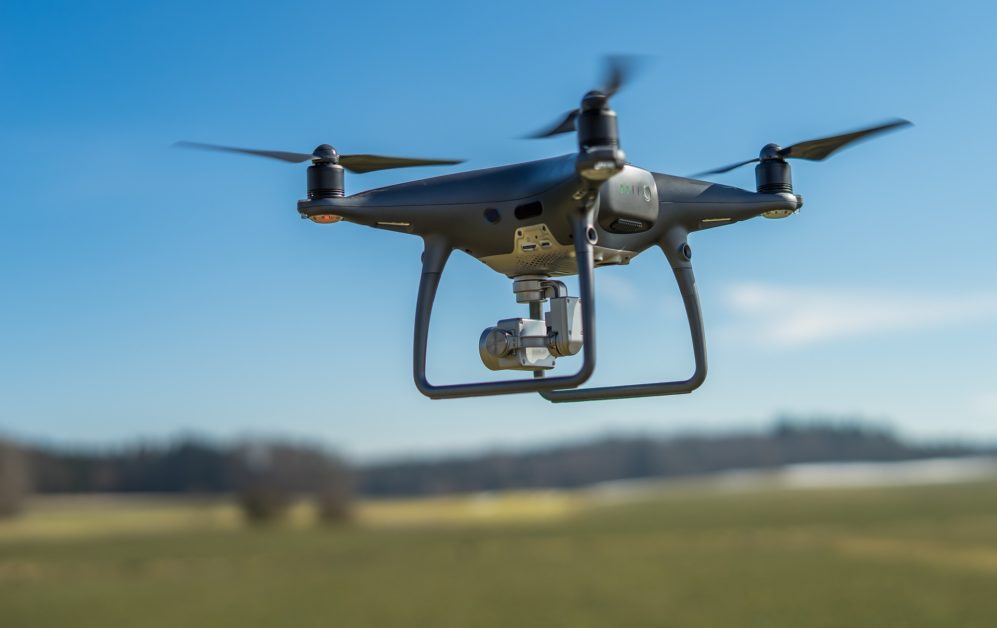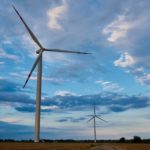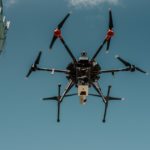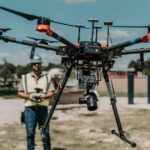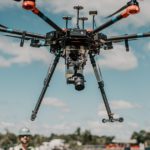All buildings require inspections during construction, and many types of buildings need to have inspections performed on a regular basis. Manual inspections can be time-consuming, costly, and dangerous. They also tend to miss minor details that can spell trouble in the future.
Drones are revolutionizing the performance of building inspections. Not only do drone inspections save time and money, but they also keep inspectors safe from harm and are highly accurate.
This article discusses the different ways drones are used in building inspections and examines the many benefits of conducting building inspections with a drone. It will also look at the best drones to use for building inspections.
How Are Drones Used for Building Inspections?
Drones are used in more and more situations to perform building inspections. By equipping drones with different kinds of technology, inspectors can thoroughly examine buildings, and many of their components. Here are a few ways that drones are used for building inspections.
Facade Inspections
The facade of a building is the section that is visible from the outside. Facades perform a number of essential functions, including:
- Preventing water from entering the building
- Controlling the exchange of air in and out of the building
- Improving energy efficiency
- Blocking out external noises
- Resisting heavy winds
- Allowing adequate light while limiting direct sun glare
With so many vital roles, it’s no wonder facade inspections are so important. Minor imperfections or damage can lead to major problems down the road. It can be challenging for visual inspectors to spot issues or signs that a facade is underperforming.
Drones, on the other hand, provide the technology to identify problems before they become visible to the human eye. They can also observe the building from perspectives that are not possible for inspectors standing on platforms above the ground.
Drones can accurately identify if moisture is entering the building from the exterior. Catching this early is critical since the smallest moisture quantity can lead to catastrophic problems. Drones can also identify areas where heat and cold are transferred at higher rates than they should.
Roof Inspections
Roof inspections are one the most important—and dangerous—parts of a home inspection. Performing a drone inspection of the roof eliminates the need for anyone to climb a ladder or step onto a potentially unstable roof.
Roof inspections are usually very time-consuming as they require lots of equipment to be set up, along with a meticulous inspection of every surface inch. Drones can quickly complete a roof inspection without the need for additional equipment. It can scan the entire roof in just a few minutes, capturing detailed images and data.
One of a roof’s most critical functions is to keep moisture out. Even the tiniest moisture quantity can cause roof damage, and in some cases, permanent structural damage. Drones equipped with thermal imaging technology will immediately spot any moisture and how it is getting in.
Drones can also identify areas of inadequate roof insulation, offering feedback that can improve a building’s energy efficiency. This increases building comfort for occupants while reducing heating and cooling bills.
HVAC
Inspection of the HVAC system is an important part of any building inspection. Drones increase the accuracy of HVAC inspections by detecting blockages and leaks, measuring airflow, and identifying heat loss from the system.
Drones are able to capture views of the HVAC system that would be hard or impossible to get otherwise. They can access the hardest-to-reach spaces, increasing the thoroughness of the inspection.
By accurately detecting minor problems early on, drone inspections prevent many costly repairs of HVAC systems in the future.
Parking Lots
Parking lots often cover a lot of ground, meaning inspections take a long time to complete. Walking a parking lot can also be dangerous during hours of operation. Drones resolve these issues by scanning the entire area in just minutes, capturing data for inspectors to review from a safe place.
High-resolution drone cameras collect detailed images of the lot, allowing immediate identification and fixing of problems, which increases the safety of building employees and patrons.
Pool Inspections
Pool inspections are crucial to ensure the pool meets all safety regulations. Inspectors look for problems with the pool’s structure, decking, or equipment. They will also use thermal imaging to check for issues with the pool’s electrical systems.
Drones are ideal for performing pool inspections because they offer a bird’s eye view of the entire pool and surrounding structures and equipment. By pinpointing problems with high accuracy, they can ensure the pool meets its safety standards, which can prevent potential injuries and even death.
Thermal Imaging
Drones used for building inspections are usually fitted with thermal imaging technology. Thermal imagers detect tiny differences in temperatures and then convert these temperature differences into an image that inspectors can view.
Thermal imaging has a wide variety of applications for building inspections. A few uses include:
- Identify hotspots in wiring and other electrical components
- Find spots of inadequate insulation
- Detect moisture and water leaks
- Monitor flow through pipes
Thermal imaging is helpful for all aspects of building inspection. It takes characteristics that are usually invisible to inspectors and turns them into concrete images that can be used to identify potential problems.
Benefits of Using a Drone for Building Inspections
There are many benefits to performing drone building inspections over traditional methods. The greatest advantages are that they are safer for inspectors, more efficient, and more thorough. Drones also capture high-definition imagery by using a number of advanced technologies. This section expands on each of these benefits.
Safer for Personnel
Manual building inspections are inherently dangerous. Viewing the roof and the upper facade requires inspectors to climb to great heights, putting them at risk of falling or dropping equipment onto people below.
Traditionally, inspectors would need to set up scaffolding, stand on high platforms, and climb tall ladders to inspect the upper portions of a building. Drones, however, eliminate the need for climbing or equipment.
The remote drone pilot navigates safely from the ground, and inspectors can review all data from a secure location. Inspections can be watched in real-time if the drone captures live feed, and all data is saved and available to inspectors from anywhere in the world.
Another danger of traditional building inspections is that inspectors may have to come into close contact with hazardous equipment or materials. For instance, a malfunctioning electrical system can pose the risk of fire or electrocution.
Often there is no way to know that the system is malfunctioning until inspectors view it up close, and by then, they are already in a dangerous position. Drones can identify electrical defects and potential hazards while keeping the pilot and inspectors at a safe distance.
Increased Efficiency
Drones increase the efficiency of all building inspections. Manual inspections are very time-consuming, and costly. They require heavy equipment to be transported to the site, set up, and finally taken down.
Traditional inspections require teams of workers to travel to a site, spending days or weeks inspecting every aspect of a building. Progress can be slower with tall structures since they must be climbed slowly and safely. And, as conditions are often dangerous, frequent safety checks must be performed, which slows progress even more.
Costs add up quickly when highly-paid skilled workers are required for entire days to complete one inspection. In addition, the job may require equipment rental or purchases, and in some cases, entire buildings must be shut down, further adding to the expense.
Drones perform inspections in minutes or hours. They can climb the height of the tallest building in two or three minutes, gathering complete data very quickly. The only personnel needed at the inspection site are the remote pilot, and possibly a spotter for a short period of time.
Building operations rarely need to be interrupted when a drone performs an inspection. Even pools and parking lots can be inspected while still in full use.
More Thorough
Drones can increase the thoroughness of inspections. Often, inspectors are unable to check every inch of a building or structure, so they inspect at intervals, resulting in minor problems staying undetected.
Drones can view buildings from many angles by taking varying routes over and around a structure, providing a much more complete view of the building, and capturing perspectives that cannot be seen during a walk-through.
During manual inspections, the only one who views each aspect of the building is the worker doing that part of the inspection. There is no way to go back and look at areas after the fact.
Using drones, entire teams of inspectors can work together to view every aspect of a building, increasing the chances of spotting issues. All data will be stored, allowing it to be reviewed indefinitely, ensuring that all potential problems are identified and addressed.
HD Imagery
Drones use HD imaging technologies to provide the highest level of accuracy. High-resolution cameras capture the tiny details missed by the human eye during inspection.
Thermal imaging accurately detects problems with electrical systems and insulation. It is invaluable in identifying problem areas where moisture enters a building, whether through the facade or roof.
LiDAR is one of the most advanced technologies used for building inspections. Sensors emit light pulses that are measured as they travel back and forth from an object. This data is used to create 3D images of an object which can be viewed by inspectors from a remote location.
A drone equipped with LiDAR sensors collects 3D images of the building it is inspecting. These images are accurate to the most minute of details.
What are the Best Drones for Building Inspections?
According to Flyability.com, the DJI Matrice 300 is the best drone for general exterior inspections, the Elios 3 is best for indoor building inspections, and the DJI Phantom 4 Pro is best for roof inspections.
Drones used for building inspections need appropriate imaging hardware and sensors, long battery life, sophisticated data collection software, and high levels of security.
The best drone for your building inspection depends on many factors, including building type, building location, and the type of inspection. To learn more about the benefits of a drone building inspection, and to determine the best drone for your purposes, contact the survey and mapping team at Fenstermaker.
Final Thoughts
Drone building inspections are safe, fast, inexpensive, and highly accurate. And, as drone technology continues to evolve, they will likely replace manual inspections altogether in the future. So, to save time and money on your next building inspection, while keeping your team safe, you should consider the benefits of using a drone.

